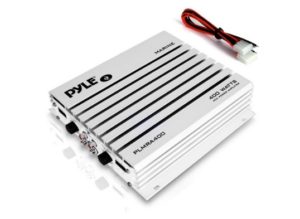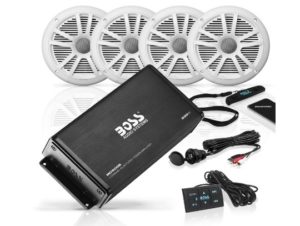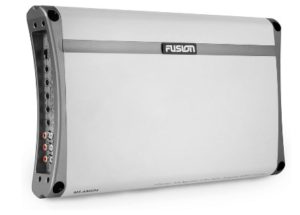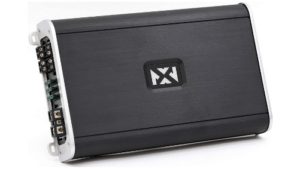Looking for the Best Marine Amplifiers? Read on for extensive and deep research on the different products in the market.
Marine amplifiers perform the important function of boosting the signal as it travels from a source component to the speakers, where it transforms the signal into sound waves.
Quality marine amplifiers are an added advantage to any marine audio system, as they enable clarity at high volumes, which eventually helps drown out background marine noise for a full, unimpeded listening experience.
Because marine audio components are constantly exposed to the elements like waves and noise, manufacturers need to build them durable. Marine Amplifiers in the market should be waterproof or water-resistant and should have protection against corrosion from salt water and salty air.
They should be powerful enough to handle high volume levels with excellent sound clarity even when there are very strong waves.
More things to look for when shopping for marine amplifiers include non-corrosive connectors coated circuit boards, plated, a rust-resistant chassis, and robust power specifications.
While there are many marine amplifiers in the market today, several stand out for their durability and performance.
Best Marine Amplifiers -Our Top Picks
1.Kenwood KAC-M1814 4-Channel
|
|
2. Pyle Hydra Marine Amplifier
|
|
3. BOSS ASK904B.64 Marine Amplifier
|
|
| 4. Garmin 010-01500-00 Fusion Marine Amplifier
|
|
| 5. NVX VAD10004 Amplifier
|
|
Criteria for Choosing the Best Marine Amplifiers
In order to make an informed decision when buying the best marine amplifiers, you need to put some factors into consideration.
Here are some of the important things to put into account;
The number of channels on the amplifier
Marine amplifiers are generally classified by the number of channels. There are multi-channel and mono channel amps. Multi-channel amplifiers have more than one channel while mono channel amplifiers have only one channel.
A channel can be defined as an electronic circuitry built into an amplifier and it’s used to provide power to a single speaker. So, multi-channel amps can power several speakers, while mono-channel amps can only drive one speaker or subwoofer at a time.
Multi-channel amps come in 2-channel, 4-channel, 5-channel, and 6-channel variety. The difference between them is pretty straightforward. 5 channels amps can drive five speakers at the same time, 2 channel amps can power two speakers, and so on.
However, some multi-channel amplifiers can have their channels reconfigured for certain specific applications. For example, a four channel amplifier can be used to power four subwoofers or four speakers or you can even bridge it to run the single subwoofer.
Mono channel amps as mentioned before and even as their name implies have one single channel. Therefore, they can only power the speaker at a time. This type of amplifiers is commonly used to drive a subwoofer.
However, the question of how many channels are needed arises. This usually depends on the setup. For example, a 2 channel marine amp would be very practical if you own a small boat with a single pair of speakers.
However, if you think you might add another pair of speakers later on then, it’s better to invest in a 4-channel amplifier, so you’ll be ready when the time comes. If your boat is equipped with a single pair of speakers and you’re adding a subwoofer, then a 3-channel amp is for you.
That said, a 4-channel amp can also be used to power a single pair of speakers and a subwoofer, with two of its channels switched to bridge mode to power the sub, and the other two to run the speakers. Bridgeable multi-channel amps allow for more flexibility.
You may also want to consider a 5-channel amplifier that can power your entire boat audio system. Some manufacturers also offer 6-channel marine amps, which can be used to run almost any speaker combination, from multiple speakers and wakeboard tower set-ups to high-powered subwoofers. This is what you need to buy if you really want to go big.
Power Output
As with marine speakers, RMS which stands for Root Mean Square is what you want to look at in an amplifier. RMS is referred to as the amount of power measured in watts that an amplifier can put out on a continuous basis.
Amplifier manufacturers are known to brag about the Peak power handling capability of their amps which is nothing but a contrivance used to entice people to buy their products.
Peak power rating only tells you the maximum wattage an amplifier can put out as short bursts. So, when looking for the best marine amplifiers in the market, remember the RMS is more accurate and more significant.
Bass Boost
This is a type of circuitry that is built into some amplifiers that allows you to boost the bass response of the amplifier, which results in improved audio reproduction. This should be a very important consideration when getting the best marine amplifiers in the market for sea life because of the different noises
Amplifier Filters
Amp filters are electronic circuits built into most marine amplifiers. They allow you to direct certain sound frequencies mostly low frequencies away from your speakers for the purpose of avoiding sound distortion.
These filters come in two types: low-pass and high-pass filters. A high-pass filter is used to direct low-frequency sounds away from yours. Likewise, a Low-pass filter is used to direct high-frequency sounds away from your sub.
Amplifier Inputs
Amplifier inputs transmit signals from your boat’s receiver to your amp. Most of, if not all aftermarket marine receivers on the market feature pre-amp outputs that allow you to connect your receiver to your amplifier directly.
However, some factory-installed receivers aren’t equipped with such output. This means that you can’t connect your receiver to the amplifier directly. In such cases, and if you have no intention to upgrade your receiver, an amplifier with speaker-level inputs is a necessity in your boat.
Amplifier Class
Marine amplifiers fall into four main different classes; class A, class B, class AB, and class D. These classes relate to the internal design and amplifiers electronic circuitry.
Why you should add an amplifier to your boat
Unlike a receiver’s built-in amp, an external amplifier is not limited by the space available as it can be designed without compromises, so it’s better and bigger. The end result is bigger and better sound, which you’ll definitely appreciate even on your open vessel.
If you’re adding aftermarket marine speakers to your system, it is, therefore, safe to assume that they will need more power than your old built-in receiver can provide. If you’re adding a subwoofer, you’ll definitely require a lot more power. If you’re into big bass, a separate amp is not only just a good idea but also an absolute necessity.
Enjoying better sound on your boat with a better stereo system
If you want to enjoy a better and bigger sound without replacing your boat’s entire receiver or speaker system, you should get a 4-channel amp. There are plenty of marine amps that are small enough to install out of sight, but they are still powerful enough to make a noticeable difference in the quality of the sound. If you’re just looking to get more out of stock or low-powered stereo, look for an amp with speaker-level inputs. Even if you have a small boat, this is a reasonably-priced upgrade that will make a difference.
Getting the most out of your new marine speakers
When you invest in a set of marine speakers for your boat, it is important to make sure that they’re getting the power they need to perform at their best. When you’re looking over the specifications you’ll see the RMS or continuous power rating. It’s usually expressed as a range “5-60 watts RMS power range” for example. The higher number represents the approximate driving power at which the speaker will sound its best, according to the manufacturer.
However, most aftermarket speakers are rated rather conservatively, so they can take a lot more power than their rating (as much as 150% of the rating is usually safe). But they really won’t sound good unless they get at least three-quarters (75%) of that power rating.
- Optimum minimum power for your speakers
If you already have aftermarket speakers, find out their top RMS rating. Most of the pairs should be the same, but if you have pairs that are slightly different, it is okay, but just use the lower rating. Multiply that number by 75% (0.75), this is the minimum RMS wattage the amp you’re looking for should have per channel.
- Optimum maximum power for your speakers
Now, for maximum power multiply that rating number by 150% (1.5), this is the maximum RMS output power per channel you’ll want for your amp. Don’t worry if you can’t find an amp small enough to match speakers with low power ratings. You can always set your amplifier’s gain low enough that it won’t ever attain its full power, so your speakers will be safe.
How many amplifier channels do you need?
If you have a smaller boat, or just don’t want a massive sound system, a 2-channel amplifier is a practical solution, if you only want to power a single pair of speakers. But if you think you might want to add another set of speakers in the future, get a 4-channel amp now, so you’ll be ready when the time comes.
If you’re thinking about adding a subwoofer, there are some other amp configurations to consider. A 3-channel amp can take care of a single pair of speakers plus a sub quite effectively. A 4-channel amp can also be employed to run a pair of speakers and a sub, with two channels bridged to run the sub and the other two to drive the speakers. With this set-up, you can change the amp over to run four speakers and add a separate amp for the sub when you decide to expand your system
Of course, you may want to consider a 5-channel amplifier that can power your entire system from one convenient package. Some manufacturers offer 6-channel marine amps, which can be configured to run almost any speaker combination from multiple speakers and tower set-ups to high-powered subwoofers. If you’re going big, this is what you need.
The perfect way to plan your marine audio system
When you’re considering what you want in a new marine audio system, one of the main questions you should ask yourself is, “Exactly how big do I want this thing to be?” Marine audio systems don’t necessarily need large amounts of amp wattage to get loud when you’re moored in a creek or tied up at the marina, but having the right amount of power makes a huge difference when you’re underway.
On a smaller boat, a 50 watts RMS per channel or even smaller amp can probably make a big difference in your overall sound. Look for speakers with a top RMS rating of at least 35 watts RMS using the 75%/150% rule to go along with the amp. If you have a bigger boat, or if you just like your music loud, you should look for an amp offering 75 watts RMS per channel at least.
A difference of 5 or 10 watts, either way, will not matter much, but somewhere in that range is the best spot. Your new speakers will each need to have a top RMS rating of 50 watts RMS or more.
Of course, there’s also the maximum power approach, which is smart and also a totally appropriate approach for speedboats and ski boats. If you already have an engine that sounds awesome, you’ll want to go for an amp with 100 watts RMS or more per channel. Get speakers or component sets rated for at least 75 watts RMS each, and you should be able to hear your music over the engine.
If you add multiple sets (on a tower, for example), make sure you have enough amps for all of them. And if you have a seriously loud high-performance engine, plan to build a system that’s powerful enough to be heard over it.
Boosting your boat bass with a subwoofer
Bass is much harder to amplify than anything else on the sound spectrum, but it’s also hard to live without if you’re used to a loud car or home stereo.
Luckily, there are numerous powerful marine subwoofer amplifiers out there dedicated solely to reproducing bass. These 1-channel “mono” amps are designed for subwoofer duty, so they work with a wide range of impedances and have tone controls and filters designed to maximize bass.
In theory, many 2- and 4-channel marine amps can be bridged in order to increase their power enough to run a sub. In practice, though, they often can’t handle the sub’s low impedance, so they overheat or go into protect mode.
A dedicated mono amp is essential if you like to hear a low-end thump at high volume. What you want is bass that blends into your overall sound instead of overwhelming it. Here’s a good rule-of-thumb guide to sub power:
- Stock stereo — 50 to 200 watts RMS of power for the bass will do nicely.
- Aftermarket stereo — you might want to have 200 to 300 watts RMS for your subwoofer.
- Amplified speakers with around 50 watts RMS per channel — plan on 250 to 500 watts RMS for bass
- A system with 100 watts RMS per channel or higher— you’ll want at least 1000 watts RMS for your sub.
It is absolutely essential to match your mono amp and subwoofer before you order either one. It would be bad if hook up your new gear and discover that the amp cannot run the subs because their impedance is too low for the amp to run without overheating.
Remember, if you’re adding a sub to a factory system; get a subwoofer amp with speaker-level inputs, so it can get a signal from the factory speaker wires.
Classes of the Best Marine Amplifiers in the Market
Like any other amplifier, a marine audio amplifier increases the power of the signal being fed to it by taking energy from its power supply and matching the signal but increasing its amplitude.
To put it in everyday terms, an amplifier takes an electric signal and makes it bigger which translates into louder and better-sounding music for us. Amplifiers use many different methods for converting these electrical signals and as you research amplifiers you will often see class A or class B and sometimes other classes altogether. So what do these classes mean and which one is right for you?
Class A
The input signal is used 100% of the time in class A amplifiers. This means that the output signal to your speakers is an exact amplified replica of the input signal that is from your head unit with almost no clipping or distortion. However, these amplifiers run extremely hot because the transistors in the amp are on all the time.
These amplifiers have a very simple circuit design compared to the other classes and have the least distortion. In a nutshell, for the price of running hot, you get great sound quality.
These types of amplifiers are used in low-power applications such as driving headphones. You will most likely not find marine audio Class A amplifiers because 1000 watts of heat could be generated just to get a few hundred watts of audio. This is not a great compromise.
Class B
In most Class B amplifiers, there are two output devices, each of which conducts alternately (meaning in a push-pull fashion). Fifty percent of the input signal is used so they only amplify half of the wave cycle.
What this means is that class B amplifiers tend to create a lot of distortion but they are far more efficient than class A amplifiers. The positive and negative halves of the input signal are dealt with by different parts of the circuit and then the output continuously switches. Still, you may never see a class B amplifier in the audio world.
These amplifiers are favored in battery-operated devices, such as transistor radios.
Class A/B
These amplifiers are the most commonly used amps of today in marine audio. They combine the best of both worlds with class B efficiency and the great sound quality of class A with low distortion. Class A/B amplifiers run very similar to class B in that half of the signal is amplified and the other half is kind of off, however, the dead zone has been reduced.
This means that a bit more of the signal is being amplified, greater than 50%, so the instance where both would be “off” has been reduced. Class A/B is a good compromise for audio amplifiers, since the average listening volume is relatively low, keeping the amplifier in the A range in terms of sound quality. When you crank the volume up the distortion levels are less than class B.
Class D
The main benefit of Class D amplifiers is the efficiency, often times at or over 90% is attainable. This efficiency is extremely high compared to class A/B amps which run less than 78% efficiently. This translates into smaller heat sinks, less power is drawn from your vehicle’s charging system, and smaller internal components.
These amplifiers switch their output devices “on” and “off” instead of always “on” which creates a square wave as opposed to an analog sine wave. This square wave contains inaccurate pulse frequency and harmonics which must be removed from the signal which is done by a technique called PWM Pulse Width Modulation.
Cleaning up the signal of a class D amplifier is relatively difficult so they are best used in applications where quality is not a factor, such as driving subwoofers. Class D amplifiers have inherently low output impedance, usually down to a 1-ohm load, which makes them ideal for running subwoofers.
High-quality class D amplifiers are starting to appear and some even rival class A/B amplifiers in terms of quality. Do not mistake a class D amplifier as being digital as this is not usually the case. Class D is simply next in the list after C. Digital class D amplifiers are controlled by digital circuits which convert the signal into zeros and ones and then digitally process the signal to remove errors. Class D amplifiers appear to be the way of the future.
Other Amplifier Classes
Some manufacturers have started producing amplifiers with class names such as bD, GH, etc. These class names do not reflect any breakthrough in technology, but rather reflect tweaks to improve on the current class A/B and D designs. For example, class GH amplifiers deliver the efficiency of a class D amp with the sound quality of an AB design.
It does this because it is not a switching amplifier (on and off) and employs different “rail” voltages with a special control circuit that switches back and forth between the rails as the signal fluctuates. This reduces the amount of wasted output power; however, these amplifiers are sophisticated and costly to produce.
As for Class bD amplifiers, they have an efficiency rating closer to that of class D amplifiers (75-80%) vs. the traditional ratings of class A/B amplifiers (20-60%).
These amps are more complex than the traditional class A/B and filtering problems are simplified. As time goes by you will see more amplifier classes appear that offer improvements over the general class A/B and class D designs.
Conclusion
Buying an amplifier should not be a hard task if you are keen on what you really want and the considerations of the marine amplifier. You have to take into consideration the factors and also understand all the classes well in order to suit your needs.
The most common amplifiers in the car audio world are class A/B and class D. You will find most speakers are run using class A/B amplifiers and subwoofers are driven by class D amplifiers.
It is difficult not to stick to that pattern of play as you will find a few deviations from it.
Read Also: 6 Best Binoculars for Boating





